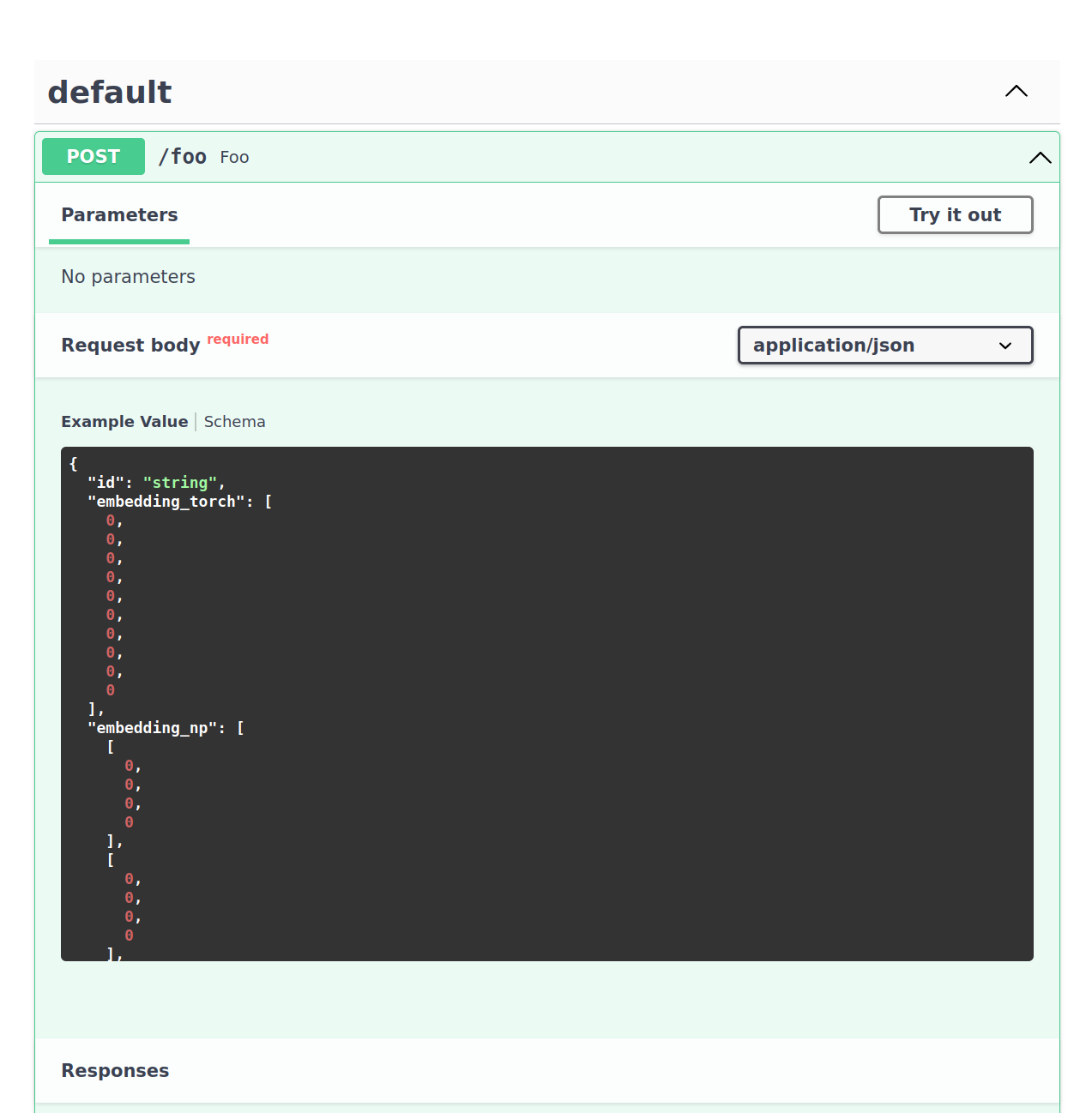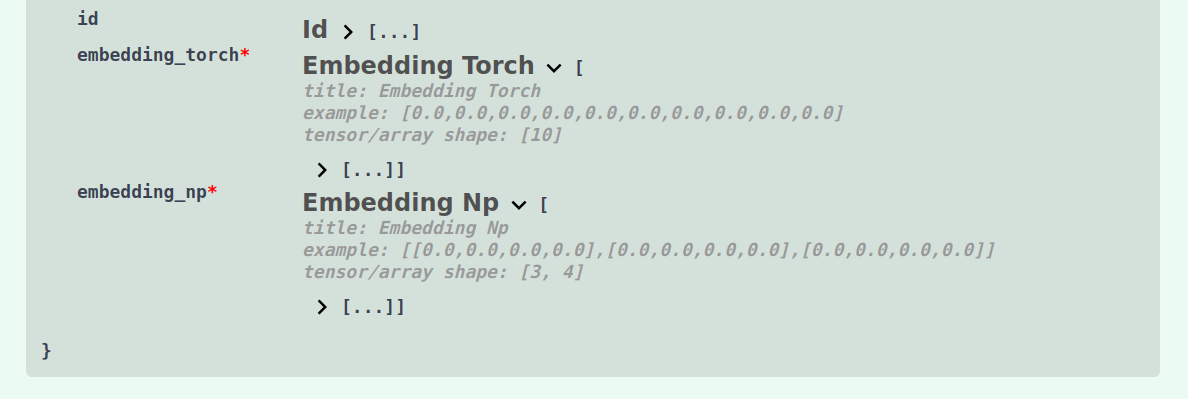Send over FastAPI
FastAPI is a high-performance web framework for building APIs with Python based on Python type hints. It's designed to be easy to use and supports asynchronous programming.
Since DocArray documents are Pydantic Models (with a twist) they can be easily integrated with FastAPI,
and provide a seamless and efficient way to work with multimodal data in FastAPI-powered APIs.
Define schemas
First, you should define schemas for your input and/or output documents:
from docarray import BaseDoc
from docarray.documents import ImageDoc
from docarray.typing import NdArray
class InputDoc(BaseDoc):
img: ImageDoc
class OutputDoc(BaseDoc):
embedding_clip: NdArray
embedding_bert: NdArray
Use documents with FastAPI
After creating your schemas, you can use your documents with FastAPI:
import numpy as np
from fastapi import FastAPI
from httpx import AsyncClient
from docarray.documents import ImageDoc
from docarray.base_doc import DocArrayResponse
input_doc = InputDoc(img=ImageDoc(tensor=np.zeros((3, 224, 224))))
app = FastAPI()
@app.post("/doc/", response_model=OutputDoc, response_class=DocArrayResponse)
async def create_item(doc: InputDoc) -> OutputDoc:
## call my fancy model to generate the embeddings
doc = OutputDoc(
embedding_clip=np.zeros((100, 1)), embedding_bert=np.zeros((100, 1))
)
return doc
async with AsyncClient(app=app, base_url="http://test") as ac:
response = await ac.post("/doc/", data=input_doc.json())
doc = OutputDoc.parse_raw(response.content.decode())
The big advantage here is first-class support for ML centric data, such as TorchTensor, TensorFlowTensor, Embedding, etc.
This includes handy features such as validating the shape of a tensor:
from docarray import BaseDoc
from docarray.typing import TorchTensor
import torch
class MyDoc(BaseDoc):
tensor: TorchTensor[3, 224, 224]
doc = MyDoc(tensor=torch.zeros(3, 224, 224)) # works
doc = MyDoc(tensor=torch.zeros(224, 224, 3)) # works by reshaping
doc = MyDoc(tensor=torch.zeros(224)) # fails validation
class Image(BaseDoc):
tensor: TorchTensor[3, 'x', 'x']
Image(tensor=torch.zeros(3, 224, 224)) # works
Image(
tensor=torch.zeros(3, 64, 128)
) # fails validation because second dimension does not match third
Image(
tensor=torch.zeros(4, 224, 224)
) # fails validation because of the first dimension
Image(
tensor=torch.zeros(3, 64)
) # fails validation because it does not have enough dimensions
Use DocList with FastAPI
Further, you can send and receive lists of documents represented as a DocList object.
To do that, you need to receive a list of documents (List[TextDoc]) in your FastAPI function, and then convert it to a DocList object.
To return a DocList object, similarly, you need to convert it to a list first.
Why is there no native support for DocList?
We would love to natively support DocList in FastAPI, but it's not possible at the moment due to some behaviour
stemming from Pydantic. This should be resolved once Pydantic v2 is released.
If you are curious about the root cause of this, you can check out the following issues: - Pydantic issue #1457 - Should be resolved in Pydantic v2 (#4161) - DocArray needs the above (#1521)
from typing import List
import numpy as np
from fastapi import FastAPI
from httpx import AsyncClient
from docarray import DocList
from docarray.base_doc import DocArrayResponse
from docarray.documents import TextDoc
# Create a docarray
docs = DocList[TextDoc]([TextDoc(text='first'), TextDoc(text='second')])
app = FastAPI()
# Always use our custom response class (needed to dump tensors)
@app.post("/doc/", response_class=DocArrayResponse)
async def create_embeddings(docs: List[TextDoc]) -> List[TextDoc]:
# The docs FastAPI will receive will be treated as List[TextDoc]
# so you need to cast it to DocList
docs = DocList[TextDoc].construct(docs)
# Embed docs
for doc in docs:
doc.embedding = np.zeros((3, 224, 224))
# Return your DocList as a list
return list(docs)
async with AsyncClient(app=app, base_url="http://test") as ac:
response = await ac.post("/doc/", data=docs.to_json()) # sending docs as json
assert response.status_code == 200
# You can read FastAPI's response in the following way
docs = DocList[TextDoc].from_json(response.content.decode())
Specify tensor shapes
DocArray enables you to serve web apps that work on tensors (from numpy, PyTorch, or TensorFlow) as input and/or output, and lets you specify and validate the shapes of said tensors.
To do that, you have to specify the expected shape in the type hint of your document.
For example, you can create the following FastAPI app in main.py:
from docarray import BaseDoc
from docarray.typing import TorchTensor, NdArray
from fastapi import FastAPI
from docarray.base_doc import DocArrayResponse
class Doc(BaseDoc):
# specify shapes of tensors
embedding_torch: TorchTensor[10]
embedding_np: NdArray[3, 4]
app = FastAPI()
@app.post("/foo", response_model=Doc, response_class=DocArrayResponse)
async def foo(doc: Doc) -> Doc:
return Doc(embedding=doc.embedding_np)
You can start the app using:
This API will now only accept an embedding_torch of shape (10,) and an embedding_np of shape (3, 4).
This is also reflected in the OpenAPI specification and SwaggerUI. Navigate to http://127.0.0.1:8000/docs to see the API documentation:


Large tensors
Rendering an example payload of a large (say, 3x224x224) tensor would prohibitively slow down the API documentation. Therefore, only tensors with a maximum of 256 elements generate a valid payload example.
If you specify a larget tensor (e.g. TorchTensor[3, 224, 224]), the example payload will show a tensor with a single
elemnt. But data validation will stil work as expected.